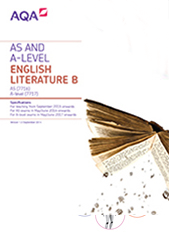Subject content – AS
This coherent specification has a distinct philosophy which centres on different ways of reading and the connections that exist between texts within a literary genre. In this way, students can gain a solid understanding of how texts can be connected and how they can be interpreted in multiple ways in order that students can arrive at their own interpretations and become confident autonomous readers. Students are then not only equipped with the knowledge and skills needed for exams, but also experience a rich, challenging and coherent approach to English literature that provides an excellent basis for further study in the subject.
The specification encourages the exploration of texts in a number of different ways:- the study of literature within a specific genre
- the study of various texts, chosen from a set text list
- writing about texts in a number of different ways.
Genre study is at the heart of English Literature B and the two broad genres available for study are tragedy and comedy. Just as meanings of texts are not fixed, neither are definitions of genre, which frequently change and become blurred. The texts offered, therefore, are not necessarily classic examples of established genres, and this is reflected in the modifying words 'aspects of'. Indeed, the specification takes into account the fact that writers often subvert the genre in which they are writing.
Working with genre involves looking at ways in which authors shape meanings within their texts. It also involves thinking about a wide range of relevant contexts, some of them to do with the production of the text at the time of its writing, some (where possible) to do with how the text has been received over time, and most of all in this specification contexts to do with how the text can be interpreted by readers now. Looking at texts as generic works involves connecting individual texts with others, as the whole idea of genre is a connective one. And finally, because genres and their qualities are not fixed, this means that interpretation is not fixed, and that multiple interpretations are possible. The flexibility offered by the choice of genres and texts ensures that you have the freedom to create a coherent course of study for your students.
The specification reflects the belief that the assessment objectives (AOs) work best together, producing a rounded and holistic view of English literature. Thus all five AOs are addressed in each question. See Assessment objectives section.
When used in AS and A-level English Literature questions, the term ‘significance’ has a very specific use and gives access to AOs 2, 3, 4 and 5. Its use here derives from semiotics and involves understanding the idea of 'signification'. In the way literary study is configured in this specification, significance involves weighing up all the potential contributions to how a text can be analysed: through the way the text is constructed and written; through text specific contexts that can be relevantly applied; through connecting the text(s) to other texts; and then finding potential meanings and interpretations.
This specification promotes as wide a choice of texts for you and your students as possible within a clear and helpful framework. The requirement in the subject criteria for students to study a minimum of four texts from particular genres and periods has been organised as follows:
| Text | Choices available |
|---|---|
| One drama text | A Shakespeare play from set list (pre-1900) |
|
One further drama text One poetry text One prose text |
From set list |
This specification has been designed to be co-teachable with the AQA English Literature B A-level specification.
